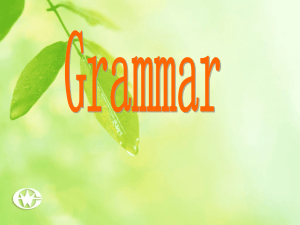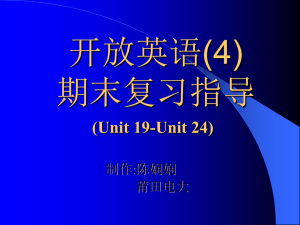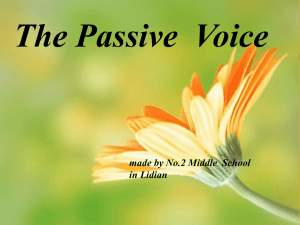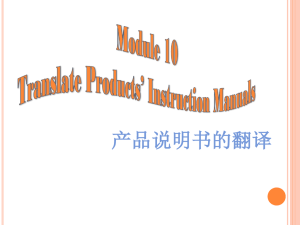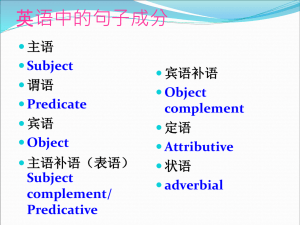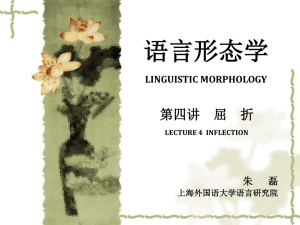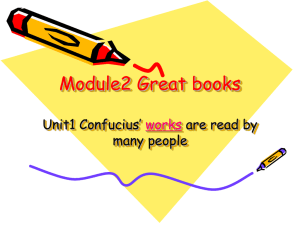PPT5
advertisement
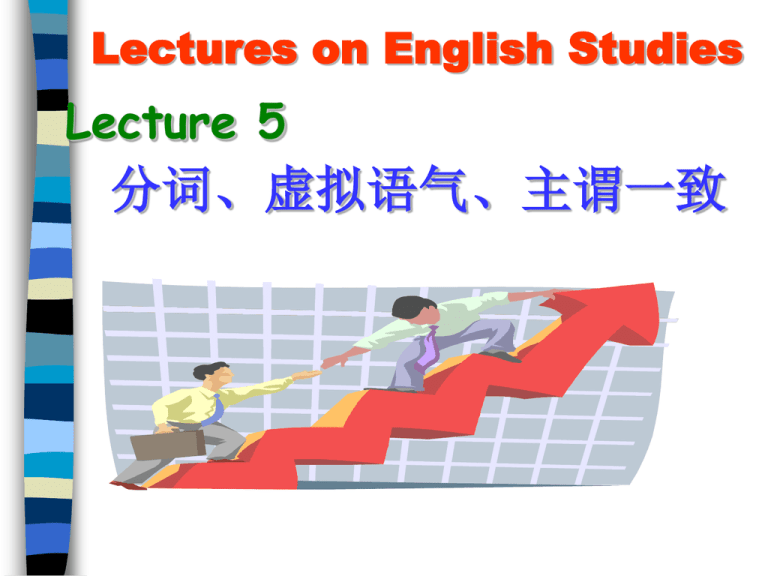
Lectures on English Studies Lecture 5 分词、虚拟语气、主谓一致 分 词 现在分词 分词 过去分词 作定语、表语、状 语、复合宾语等 现在分词的形式: 一般式 完成式 主动形式 doing having done 被动形式 being done having been done 过去分词表示完成的和被动的动作,只有 一种形式。 现在分词表示主语所具有的特征 1.作表语 2.作定语 现在分词 过去分词多表示主语所处的状态 表示正在进行的动作(变为 从句时需用进行时态) 表示经常性动作或现在(或当 时)的状态(变为从句时用一 般时态) 过去分词 表示的动作在谓语所表示 的动作之前发生 或是没有一定的时间性 3. 作状语 表示主语正在进行的另一动 作,对谓语表示的主要动作 加以修饰或作为陪衬。 修饰谓语,说明动作发生的 背景或情况。 分词短语用作状语表示原因时,相当于 一个表示原因的状语从句。 4. 作复合宾语: 分词可以在see, hear notice, watch, keep, find, get, have, feel 等动词后与一个名词 (代词)构成复合宾语。 5.现在分词的完成形式和被动形式 现在分词的完成形式:用在状语中,表 示这动作在谓语所表示的动作之前发生。 现在分词的被动形式:在表示一个被动 动作时, 如果这动作是现刻正在进行的 (a),或是与谓语表示的动作同时发生 的(b),可用现在分词的被动形式。 虚拟 语气 1.常用虚拟条件句 1)would + 动词原形 + but + 现在时 陈述句 -----------表示同现在事实 相反的假设 2)would + have +过去分词 + but + 过去时陈述句 ----表示同过去事实 相反的假设 2.虚拟语气的其他一些结构 (1) If it were not for sth…, 如果没有,表示同现在事实相反 If it had not been for sth…, 如果当时没有,表示同过去事实相反 (for 不能省略) 3.省略if if引导的条件从句含有were, should, had时,可以省略if并 把主谓倒置 4.与介词连用 without, but for, in case of Helen would not be able to live without ( =if it were not for…) her considerate husband. But for (=if it had not been for 要不 是)your timely rescue, the boy would have drowned. 5.虚拟语气在从句中的应用 1)在表示愿望、建议、命令等的从句中: a) wish 后的宾语从句 b) suggest, order, demand, propose, command, request, desire, insist 等动词后 的宾语从句中 c) it is desired, it is suggested, it is requested, it was ordered, it was proposed, it is necessary, it is important, it has been decided 等结构后的主语从句 d) suggestion, motion, proposal, order, recommendations, plan, idea 等后面的表 语从句和同位语从句 e) 在it is time后的定语从句中 2) 以as if(though), in order that, so that, Lest, for fear that,和 in case引起的从句 3)以whatever,Whoever, no matter what 之类代词或词组引起的从句 主谓一致 1)谓语动词在人称和数上必须与主语 一致 a) 在there be结构中 There is no smoke without fire. There seem to be too many men in the field. 注:在there, here引起的结构中,如主 语有好几个,则谓语动词可与最邻近 的主语取得一致。(就近原则) b) 在倒装结构中 Here come the five noisy children from next door. c) 在主语后有修饰语的句子中 Differences in speech often cause people to snigger. d)在主语后有“as well as, not to mention, along with等+名词”句子中 此外,主语后若跟有 accompanied by, as much as, besides, except (but), in addition to, including, no less than, instead of, rather than, together with 等+名词, 也不影响其与谓语动词的一致关系。 2)单数主语 a) 不定式短语,动词-ing形式(短语)及 名词从句作主语时, 谓语动词用单数。 b) 下列不定代词或限定词作主语或修饰 主语时, 谓语动词永远是单数。 Every silver knife, fork, and spoon has to be counted. Each book and magazine is listed in the card catalog. (注: every和each后面的名词为单数) Everyone/Everybody is here. Each of the students has a schedule. (注:each of 后的名词必须是复数) 3)带有量词的主语与谓语动词的 一致 以下句中主语的数取决于介词of后的名 词的数 a) A lot of the equipment is new. b) A lot of my friends are here. c) All of the fruit looks ripe. d) All of the cherries are here. k) None of the evidence points to his guilt. l) None of our students were involved. (注:在非正式语体中,该句中的谓语 动词可用was。如要表达单数概念, 最好将句中的主语改为no one 或not one.) 但 The number of students in the class is fifteen. • A number of students were late. (注:A number of 后用复数名词,并 用复数谓语动词。) o) More than one person is involved in this case. p) More than one hundred men and women are working in this workshop. q) The majority were/was in favor of the proposal. r) The majority of boys like football. 4)并列主语 a) 由and或both…and…连接两个主语 时,谓语动词一般用复数。 b) 由 or, either…or, 或neither…nor连接 两个单数主语时,谓语动词用单数。 c) 当or, either…or…, neither…nor或 not only… but (also)连接一个单数主 语和一个复数主语时,谓语动词取决 于最接近它的名词或代词的数。 d) 但当并列主语作为整体考虑, 或在意 义上指同一人,同一事物时,谓语动词 用单数。 Ice cream and cake is my favorite dessert. 两个单数名词前都有冠词时,谓语动词 常用复数。 The editor and the publisher of this magazine are very able men.(指两个人) The editor and publisher of this magazine is a very able man.(指同一个 e)集体名词作主语 集体名词作主语时, 谓语动词的数 取决于主语表示的意义。当主语表 示不可分割的整体时,谓语动词用 单数;当主语强调集体中的各个成 员时,谓语动词用复数。 f)其他情况下的主谓一致 1)表示时间,金钱,距离,体积, 小数等名词词组作主语时, 其谓 语动词常用单数。 Eight hours of sleep is enough. Twenty dollars is too much to pay. Three thousand miles is too far to travel. 2) Chinese, English, French, Japanese等词指语言时,用单数; 指人民时,用复数。 3) “The + 形容词/动词-ed形式”作主 语如果表示一类人,谓语动词用复 数。 The young are full of vigor. The injured were taken to hospital.


